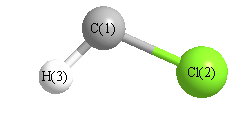Jump to
S2C1
Energy calculated at CISD/6-31G
| | hartrees |
|---|
| Energy at 0K | -497.879930 |
| Energy at 298.15K | -497.879719 |
| HF Energy | -497.748745 |
| Nuclear repulsion energy | 35.778349 |
The energy at 298.15K was derived from the energy at 0K
and an integrated heat capacity that used the calculated vibrational frequencies.
Geometric Data calculated at CISD/6-31G
Point Group is Cs
Cartesians (Å)
| Atom |
x (Å) |
y (Å) |
z (Å) |
|---|
| C1 |
0.046 |
1.304 |
0.000 |
| Cl2 |
0.046 |
-0.550 |
0.000 |
| H3 |
-1.059 |
1.517 |
0.000 |
Atom - Atom Distances (Å)
| |
C1 |
Cl2 |
H3 |
| C1 | | 1.8537 | 1.1255 |
Cl2 | 1.8537 | | 2.3434 | H3 | 1.1255 | 2.3434 | |
 More geometry information
More geometry information
Calculated Bond Angles
| atom1 |
atom2 |
atom3 |
angle |
|
atom1 |
atom2 |
atom3 |
angle |
| Cl2 |
C1 |
H3 |
100.898 |
|
Electronic energy levels
Charges, Dipole, Quadrupole and Polarizability
Jump to
S1C1
Energy calculated at CISD/6-31G
| | hartrees |
|---|
| Energy at 0K | -497.893479 |
| Energy at 298.15K | -497.893287 |
| HF Energy | -497.785368 |
| Nuclear repulsion energy | 36.654798 |
The energy at 298.15K was derived from the energy at 0K
and an integrated heat capacity that used the calculated vibrational frequencies.
Geometric Data calculated at CISD/6-31G
Point Group is Cs
Cartesians (Å)
| Atom |
x (Å) |
y (Å) |
z (Å) |
|---|
| C1 |
0.037 |
1.239 |
0.000 |
| Cl2 |
0.037 |
-0.546 |
0.000 |
| H3 |
-0.860 |
1.856 |
0.000 |
Atom - Atom Distances (Å)
| |
C1 |
Cl2 |
H3 |
| C1 | | 1.7855 | 1.0889 |
Cl2 | 1.7855 | | 2.5643 | H3 | 1.0889 | 2.5643 | |
 More geometry information
More geometry information
Calculated Bond Angles
| atom1 |
atom2 |
atom3 |
angle |
|
atom1 |
atom2 |
atom3 |
angle |
| Cl2 |
C1 |
H3 |
124.489 |
|
Electronic energy levels
Charges, Dipole, Quadrupole and Polarizability
